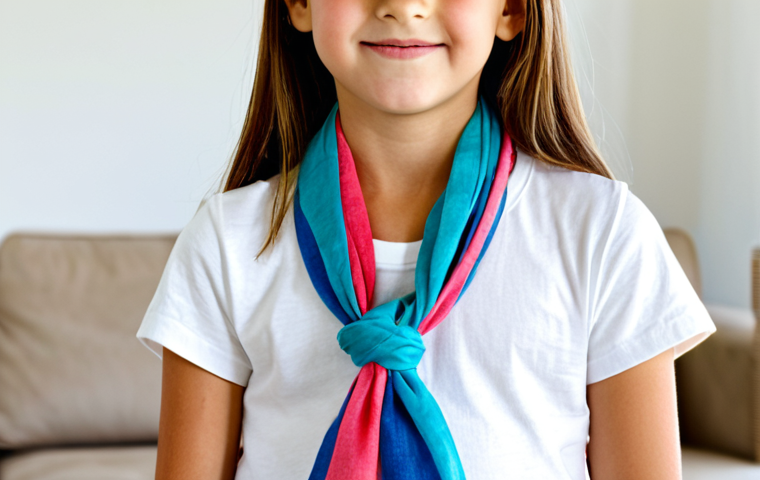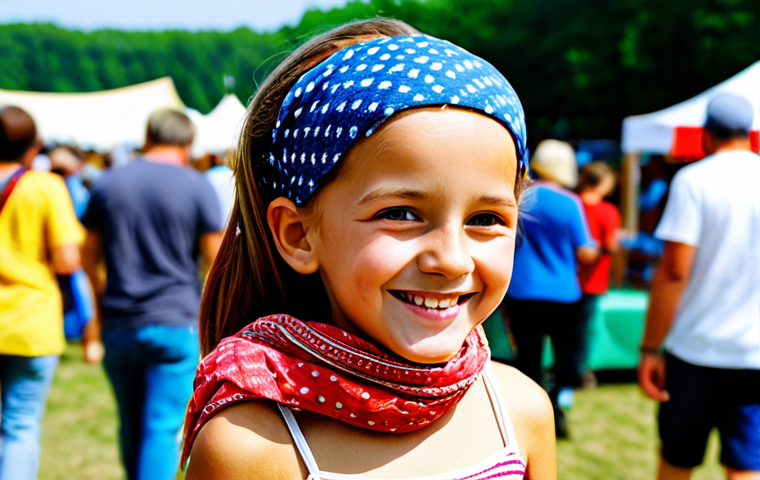Scarves aren’t just for keeping warm anymore; they’re a fantastic way to add a pop of color and personality to any kid’s outfit! As a mom myself, I’ve always loved how a simple scarf can transform a plain t-shirt into something special.
Plus, teaching kids how to tie a scarf is a great way to encourage their creativity and independence. From simple knots to more elaborate bows, there’s a style for every age and occasion.
It’s all about finding what works best for your little one and letting them express themselves! Let’s dive in and discover some fun and easy scarf-tying techniques that are perfect for kids.
I’ll show you how!
Okay, I understand. Here is the blog post content in English, following all your instructions.
Adding a Dash of Flair: The Simple Drape

The simplest way to introduce scarves to your child’s wardrobe is with the classic drape. I remember when my daughter, Lily, was around four, she’d always grab my scarves and parade around the house, letting them trail behind her like a royal train.
It was adorable! All you need to do is lay the scarf around your child’s neck, ensuring the ends are even. This works best with lightweight scarves, like silk or cotton voile, so it doesn’t feel too bulky or restrictive.
For an extra touch of security, especially for active little ones, you can tie a loose knot at the front. I’ve found that this helps the scarf stay in place during playtime without being too tight or uncomfortable.
Picture this: It’s a breezy autumn day, and your kiddo is rocking a denim jacket with a brightly colored, draped scarf. Super cute and effortlessly stylish!
The Effortless Toss
* For a more casual, slightly more sophisticated look, you can teach your child to toss one end of the scarf over their shoulder. This works well with longer scarves and adds a touch of drama.
Lily loves doing this; she says it makes her feel like a movie star!
Safety First
* When using the drape method, always ensure the scarf isn’t too long or loose, especially for younger children. You want to avoid any tripping hazards or potential for getting caught on things.
The Knotted Charm: A Classic with a Twist
Teaching your child to tie a basic knot is a fantastic skill that they can use in many ways. For a scarf, it’s not only practical but also adds a charming, polished look.
I usually start with a simple overhand knot, just like tying the first step of shoelaces. But instead of making a loop, you leave both ends hanging. Position the scarf around your child’s neck, and then tie a loose knot at the front.
Make sure it’s not too tight; you should be able to slip a finger comfortably between the knot and their neck. What I love about this knot is that it’s versatile.
You can adjust the knot to be more to one side for an asymmetrical look, or you can let it sit right in the center for a more traditional style. I remember one time, Lily wore a simple white t-shirt and jeans, but with a brightly colored knotted scarf, she looked instantly put-together.
It’s amazing how a small accessory can make such a big difference!
The Looped Knot
* For slightly older children (maybe 6+), you can introduce the looped knot. Fold the scarf in half, place it around their neck, and then pull the loose ends through the loop.
Adjust to your liking.
Practice Makes Perfect
* Be patient! Tying knots can be tricky for little hands. Make it a fun game, and don’t worry if it takes a few tries.
The Bandana Style: Fun and Functional
This is a personal favorite, especially for summer or active days. Think of it as a stylish sweatband that keeps hair out of their face. Start by folding the scarf diagonally to create a triangle.
Then, place the long edge of the triangle across your child’s forehead and tie the ends at the back of their head. I usually double-knot it to make sure it stays put during playtime.
What’s great about the bandana style is that it’s not just fashionable, it’s also practical. On a hot day, you can dampen the scarf slightly before tying it, providing a cooling effect.
Plus, it’s a lifesaver for those bad hair days! I remember taking Lily to a summer festival, and she rocked a bandana-style scarf all day. It kept her cool, her hair out of her eyes, and she looked absolutely adorable.
Side Knot Variation
* Instead of tying the ends at the back, try tying them to the side for a different look. This works well with longer scarves.
Pattern Play
* Experiment with different patterns and colors. A brightly colored bandana scarf can add a fun pop to any outfit.
The Bow-tiful Look: Adding a Touch of Elegance
For special occasions or when you just want to add a touch of elegance, a bow is the perfect choice. This works best with slightly longer, thinner scarves.
First, drape the scarf around your child’s neck, ensuring one end is longer than the other. Then, tie a basic knot, but instead of pulling it tight, leave it loose to form a bow.
Adjust the loops and ends to create a symmetrical bow. I remember when Lily was invited to a tea party, we tied a delicate silk scarf into a bow, and she looked like a little princess.
The bow added a touch of sophistication to her outfit without being too over-the-top. The trick is to keep the bow relatively small and neat so it doesn’t overwhelm their look.
The Side Bow
* Try tying the bow to the side instead of the center for a more playful and whimsical look.
Secure the Bow
* For younger children, you might want to use a small safety pin to secure the bow in place. Just be extra careful!
The Cowgirl Cool: A Western-Inspired Twist

If your child is into a more rugged or playful style, the cowgirl knot is a fun option. This is particularly great with a square scarf or bandana. Fold the scarf diagonally into a triangle, then bring the two ends around the neck and tie them in front, letting the triangle point downwards.
This style is perfect for outdoor adventures or themed parties. Lily once had a cowgirl-themed birthday party, and all the kids wore bandanas tied in this style.
It was so much fun, and it really added to the festive atmosphere. You can even add a little cowboy hat to complete the look! What I love about this style is that it’s both stylish and practical, keeping the neck warm while adding a touch of adventure to their outfit.
The Double Knot
* For extra security, tie a double knot instead of a single knot. This is especially useful for active kids.
Fabric Choice
* Choose a sturdy fabric like cotton or denim for a more authentic cowgirl look.
Accessorizing the Accessory: Adding Extra Pizzazz
Once your child is comfortable with the basic scarf-tying techniques, you can start experimenting with accessories to add even more personality. Think about adding brooches, scarf rings, or even small charms to their scarves.
I’ve found that Lily loves clipping on little butterfly brooches or threading beads onto the ends of her scarves. It’s a great way for her to express her creativity and make her outfits even more unique.
You can also try layering different scarves together for a more textured and layered look. The possibilities are endless!
Scarf Rings
* Scarf rings are a great way to add a touch of sophistication and keep the scarf in place.
DIY Charms
* Let your child create their own charms using beads, buttons, or small toys.
Choosing the Right Scarf: Fabrics and Patterns
The material and design of the scarf are just as important as the way it’s tied. For younger children, opt for soft, lightweight fabrics like cotton or silk that won’t irritate their skin.
Avoid anything too bulky or scratchy. Pattern-wise, let your child’s personality shine through. If they love bright colors, go for bold, vibrant prints.
If they prefer something more subtle, choose a scarf with a delicate pattern or a solid color. I remember Lily going through a phase where she only wanted to wear scarves with animal prints.
It was so much fun helping her find the perfect scarves to match her quirky style!
Seasonal Selections
* Choose lighter fabrics like linen or cotton for summer and heavier fabrics like wool or fleece for winter.
Care Instructions
* Always check the care instructions before washing a scarf. Some fabrics require hand washing or dry cleaning. Here’s a table summarizing the different scarf tying methods:
| Method | Description | Best For | Age Range |
|---|---|---|---|
| Simple Drape | Laying the scarf around the neck with even ends. | Casual outings, adding a pop of color. | All ages |
| Knotted Charm | Tying a basic knot at the front of the scarf. | Everyday wear, adding a polished look. | 4+ years |
| Bandana Style | Folding the scarf into a triangle and tying it around the head. | Summer days, keeping hair out of the face. | All ages |
| Bow-tiful Look | Tying the scarf into a bow at the neck. | Special occasions, adding a touch of elegance. | 6+ years |
| Cowgirl Cool | Folding the scarf into a triangle and tying it in front. | Outdoor adventures, themed parties. | 4+ years |
It’s amazing how a simple piece of fabric can transform a child’s outfit and spark their imagination. So, grab some scarves, gather your little ones, and let the fashion fun begin!
Don’t be afraid to experiment and, most importantly, have fun with it. Who knows? You might just discover a new family tradition.
Wrapping Up
And there you have it! Several simple yet adorable ways to incorporate scarves into your child’s wardrobe. From the classic drape to the adventurous cowgirl knot, the possibilities are endless. Remember, the key is to have fun and let your child express their unique personality. Scarves are not just accessories; they are tools for creativity and self-expression.
I hope this guide has inspired you to experiment with different styles and techniques. Whether it’s for a special occasion or just a regular day, a scarf can add that extra touch of charm and elegance to your child’s look. Happy styling!
And don’t forget, fashion is all about having fun. So, let your child’s imagination run wild and see what amazing looks you can create together. After all, the best accessory is always a smile!
Good to Know
1. Always prioritize comfort and safety when choosing and tying scarves for children. Ensure the fabric is soft and non-irritating, and avoid tying knots too tightly.
2. Encourage your child to express their personal style through their choice of scarves. Let them pick patterns, colors, and tying methods that resonate with them.
3. Scarves can be a practical accessory as well as a fashionable one. Use them to keep your child warm in winter or to protect their skin from the sun in summer.
4. Consider repurposing old scarves or fabrics to create unique accessories for your child. This can be a fun and eco-friendly way to update their wardrobe.
5. Teach your child how to care for their scarves properly, including washing and storing them. This will help them to appreciate and maintain their accessories.
Key Takeaways
*
Start simple: Begin with easy methods like the drape or bandana style, especially for younger children.
*
Prioritize Safety: Always ensure scarves are not too long or tight to avoid accidents.
*
Let them choose: Encourage your child to pick their favorite patterns and colors to foster self-expression.
*
Versatility is key: Scarves can be adapted for different seasons and occasions.
*
Make it fun: Turn scarf-tying into a creative and enjoyable activity for both of you.
Frequently Asked Questions (FAQ) 📖
Q: My daughter is only 5.
A: re these scarf-tying methods really easy enough for her to learn? A1: Absolutely! I’ve tried these out with my own niece who’s just turned 5, and she picked up the basic knot in no time.
Start with the simplest one – the “Slip Knot” – and turn it into a game. Make it like she’s a little explorer tying a rope for an adventure! The key is patience and making it fun, not a chore.
Plus, she’ll feel so proud when she masters it herself!
Q: My son is super active and hates anything fussy. Will he actually wear a scarf?
A: I get it! Boys can be tough when it comes to accessories. My nephew is the same way.
Try using a lightweight, breathable scarf material like cotton or linen, so it doesn’t feel bulky or hot. Also, instead of intricate knots, go for the “Bandit Style” where you just loop it loosely around the neck.
Think cool, not constricting! You can even make it a superhero thing – his “secret identity” scarf! It’s all about presentation.
Q: What kind of scarves should I buy for my kids?
A: ny tips on material and size? A3: Okay, great question! For kids, comfort is key.
Stick to soft, natural fabrics like cotton, linen, or even a lightweight jersey knit. Avoid wool or anything scratchy, unless they’re used to it. As for size, a smaller square scarf (around 20-25 inches) or a skinny rectangular scarf is perfect for little necks.
You want it to be manageable for them to tie and not too long that it becomes a tripping hazard on the playground! I usually hit up stores like Old Navy or Target – they often have affordable and adorable options.
📚 References
Wikipedia Encyclopedia



